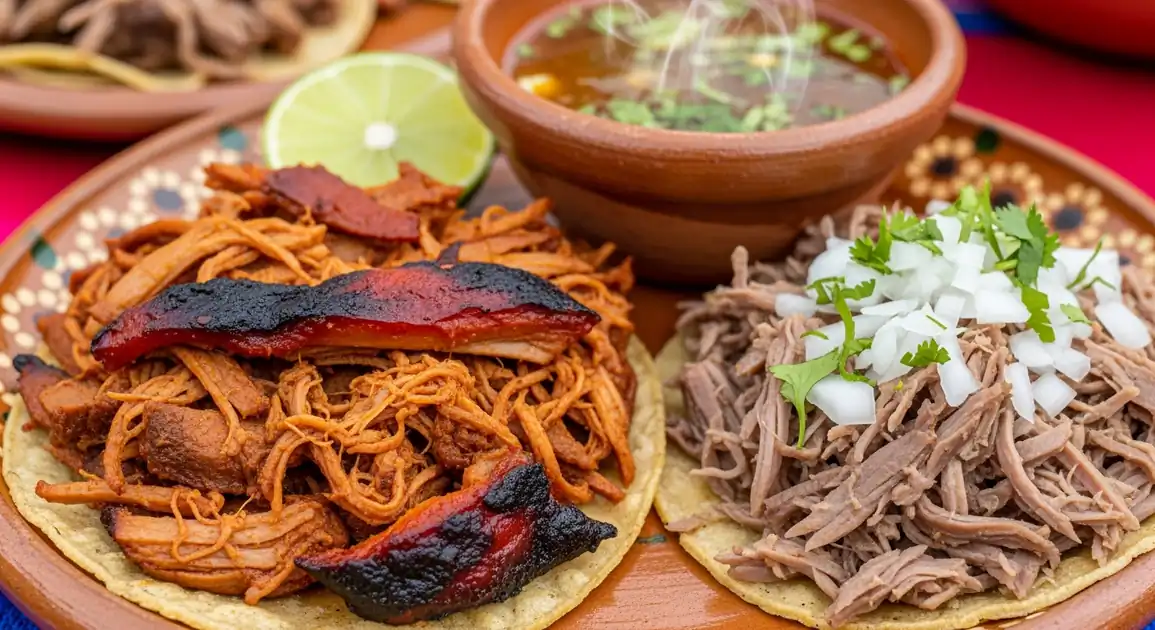Goat Barbacoa
Barbacoa de Chivo

Description
Oaxaca is renowned for its exceptional Barbacoa de Chivo, often prepared using the traditional pit-cooking method ('en pozo') wrapped in maguey leaves. The Oaxacan style typically features a rich, complex adobo. It's a highlight of local markets, especially the famous Sunday market in Tlacolula, and a staple at Oaxacan celebrations.
Dietary Information
Serving information
Serving style
Served as tacos ('tacos de barbacoa') with Oaxacan corn tortillas, finely chopped onion and cilantro, lime, and typically a red, moderately spicy salsa. The rich consommé, sometimes with chickpeas, is essential. Sold by the taco or kilo.
Quick facts
Predominantly Saturday and Sunday mornings, roughly 7:30 AM until 2 PM or sold out. Some city stalls might have limited weekday availability.
Safety Tips
What to Look For
-
Meat kept visibly steaming hot
Ensures the meat is held at a safe temperature (above 60°C / 140°F) to prevent bacterial growth. Look for steam rising from the pot or serving container.
-
Consommé served piping hot
The broth should be very hot, not lukewarm. This indicates proper temperature control and enhances safety and flavor.
-
Clean serving area and utensils
Check for clean cutting boards (ideally separate for raw/cooked, though barbacoa is usually handled cooked), knives, condiment containers, and vendor hand hygiene.
-
High customer turnover (busy vendor)
Popular stalls usually mean the food is fresh and doesn't sit around for long periods. Locals lining up is often a good sign.
-
Vendor reputation (ask locals)
If possible, ask locals for recommendations. Established vendors known for quality are generally safer bets.
What to avoid
-
Meat sitting out at room temperature or looking dry/old
Barbacoa should be moist and kept hot. Avoid vendors where the meat looks like it's been sitting uncovered or unheated for a while.
-
Lukewarm consommé
Broth not kept sufficiently hot poses a food safety risk.
-
Dirty stall or poor vendor hygiene
Visible grime, flies, or vendors handling money and food without washing hands/using gloves are red flags.
-
Re-heated barbacoa (unless done properly)
Freshly cooked or properly hot-held barbacoa is best. Be cautious if it seems like leftovers are being quickly reheated.
Price information
Price range
Budget tips
- Tacos are usually priced per piece (25-40 MXN depending on size/vendor).
- Buying by weight (around 450-600 MXN per kilo) is cost-effective for sharing.
- Market prices (like Tlacolula) are generally competitive.
- Consommé is often inexpensive or sometimes included with a larger order.
Value indicators
- Deep red color from the Oaxacan adobo.
- Smoky aroma if cooked 'en pozo'.
- Extremely tender meat.
- Served with fresh, high-quality local condiments and good tortillas.
- Vendors specializing only in barbacoa often have high standards.
Where to Find This Dish
Tlacolula Sunday Market
Famous destination for high-quality, traditional Barbacoa de Chivo, often cooked 'en pozo'. Numerous vendors set up here.
Market grounds near the Templo de Santa María de la Asunción
Sunday Morning (8 AM - 1 PM)
Mercado Benito Juárez / 20 de Noviembre (Oaxaca City)
Central markets in Oaxaca City where dedicated barbacoa stalls operate, especially on weekends.
Central Oaxaca City markets
Weekend mornings (8 AM - 2 PM)
Zaachila Market (Thursdays)
Another important regional market where traditional barbacoa can be found.
Zaachila town market area
Thursday Morning (8 AM - 1 PM)
Roadside Stands (Various towns)
Look for established stands on the outskirts of towns like Mitla or Etla, particularly on weekends.
Main roads entering/leaving towns
Weekend mornings
Vendor Tips
- At Tlacolula, explore different vendors; some specialize in specific parts or have slightly different adobos.
- Ask if it's cooked 'en pozo' if you seek the most traditional flavor.
- Order consommé 'con garbanzo' (with chickpeas) if available and desired.
- Be prepared for crowds, especially at Tlacolula on Sundays.
How to Order
Regional Variations
-
Oaxacan Adobo Specifics
(Adobo Oaxaqueño)
Often uses local chilies like 'chilhuacle' or 'pasilla Oaxaqueño' (though guajillo is common), contributing unique flavor notes compared to other regions.
-
Use of Maguey Leaves
(Uso de Pencas de Maguey)
Emphasis on wrapping the meat in maguey leaves during pit cooking ('en pozo') is strong in Oaxaca, adding moisture and a distinct flavor.
-
Serving with 'Seguesa' (less common)
(Servido con Seguesa)
Occasionally, barbacoa might be accompanied by or incorporated into 'seguesa', a type of thick corn masa-based mole or stew, though this is rarer for typical barbacoa servings.
Cultural context
History
The term 'barbacoa' originates from the Taíno word 'barabicu', referring to slow-cooking meat over a fire or in a pit. This technique was adopted and adapted across Mexico, utilizing local meats and ingredients. Cooking barbacoa, especially for celebrations and weekend gatherings, is a deeply rooted tradition. Goat ('chivo') became a popular choice in regions suited for goat herding, like the semi-arid landscapes of Oaxaca, evolving into a distinct regional specialty.
Local significance
Barbacoa de Chivo is deeply embedded in Oaxacan culture, representing communal feasts, market day traditions, and culinary heritage linked to indigenous practices.
Eating customs
- Enjoying it with local Oaxacan tortillas (often slightly larger/thicker).
- Pairing with local drinks like tejate or aguas frescas.
- Sharing large platters or kilos among groups is common.